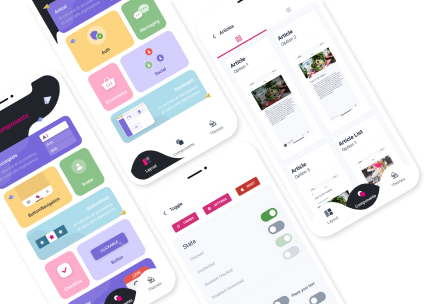Best Practices for Managing An Outsourced Software Development Team
Outsourcing offers significant advantages, including cost savings, access to specialized skills, and accelerated time-to-market. A Deloitte study found that 59% of businesses cite cost-cutting as a primary reason for outsourcing. However, communication barriers, quality control issues, and data security risks must be managed carefully.
According to Precedence Research, the global IT outsourcing market is projected to reach $1.149 billion by 2032, highlighting its growing importance. While outsourcing can drive innovation and competitiveness, success requires strategic partner selection, clear communication protocols, and robust project management.
This guide explores the key challenges of software development outsourcing. It offers practical strategies for businesses to maximize advantages while mitigating risks. We'll cover partner selection, communication best practices, quality assurance, and legal considerations to help you make informed decisions and drive sustainable growth in today's competitive digital landscape.

Potential Risks of Outsourcing Software Development
Despite its numerous advantages, outsourcing software development comes with several potential risks and challenges that organizations need to be aware of and address:
Communication Barriers
One of the most significant challenges in outsourcing is effective communication. Language differences, cultural nuances, and time zone disparities can lead to misunderstandings and miscommunication. This can result in:
- Misinterpretation of project requirements
- Delays in project timelines
- Increased frustration among team members
- Reduced productivity and efficiency
Quality Control Concerns
Maintaining consistent quality across remote teams can be challenging. Some key issues include:
- Varying coding standards and practices
- Difficulty in monitoring day-to-day progress
- Inconsistent testing and quality assurance processes
Data Security and Intellectual Property Risks
Sharing sensitive information and intellectual property with external partners poses significant risks:
- Potential data breaches or leaks
- Unauthorized access to confidential information
- Intellectual property theft or misuse
Cultural Differences
Varying work ethics, business practices, and cultural norms can lead to:
- Misaligned expectations regarding work hours and availability
- Different approaches to problem-solving and decision-making
- Potential conflicts due to misunderstandings of cultural norms
Hidden Costs and Budget Overruns
Outsourcing can sometimes lead to unexpected expenses:
- Additional charges for changes or unforeseen requirements
- Costs associated with project management and communication
- Expenses related to travel or on-site visits
Careful planning, thorough vetting of outsourcing partners, and ongoing management and communication are key to successful software development outsourcing.

Best Practices for Managing Outsourced Software Development Teams
Effective management is key to realizing the full potential of your outsourced team. By implementing proven strategies, you can ensure smooth collaboration and successful project outcomes.
Establish Clear Communication Channels
To communicate effectively in outsourcing, identify the tools and protocols to facilitate seamless interactions. Slack is great for day-to-day communication, while Zoom can be used for video conferences that require face-to-face interaction.
Establish a regular meeting cadence, including daily standups to address pressing concerns and weekly progress reviews to ensure everyone is aligned on project goals.
Additionally, clear reporting structures and escalation processes should be implemented. This ensures issues are resolved quickly and efficiently, maintaining project momentum and team morale.
Implement Effective Project Management Methodologies
Choosing the right project management methodology can significantly impact your outsourcing success. Agile methodologies, such as Scrum or Kanban, are particularly well-suited for software development projects due to their flexibility and iterative nature. These approaches allow for rapid adjustments based on feedback and changing requirements.
For more complex projects, consider adopting hybrid approaches that combine elements of Agile with traditional methods; some key benefits of Agile for outsourcing include:
- Sprints: Short 1-4 week cycles allow frequent releases and feedback. This helps catch issues early and keeps the project aligned with changing needs.
- Daily standups: Brief daily team meetings quickly facilitate communication across time zones and surface blockers.
- User stories: Breaking work into small, user-focused chunks makes assigning tasks and tracking progress easier.
- Retrospectives: Regular team reviews identify process improvements to increase productivity and quality over time.
- Backlog grooming: Ongoing refinement of requirements and priorities enables fast pivots when needed.
This flexibility can be crucial when managing diverse teams across different time zones. To support these methodologies, leverage remote management tools like Jira or Trello. These platforms facilitate task tracking and collaboration and provide real-time visibility into project progress, ensuring everyone stays on the same page regardless of location.
Clear communication and the right methodology are crucial in managing diverse teams across different time zones.
Set and Manage Expectations Clearly
Your business should start by defining a detailed project scope that outlines all requirements, milestones, and goals to be achieved. This comprehensive outline is a roadmap for your outsourcing team, minimizing misunderstandings and ensuring everyone is working towards the same goals.
Establish specific quality standards and acceptance criteria for all goals to be achieved. Identify key performance indicators (KPIs) to measure team and project performance. These metrics provide objective insight into progress and areas for improvement, allowing for data-driven decision-making throughout the project lifecycle.
Build Trust with Remote Teams
Building trust is essential when working with remote teams. Invest time learning about your team's cultural background to foster mutual understanding and respect. This cultural awareness can prevent misunderstandings and create a more harmonious work environment. Ngoài ra, còn có một số hoạt động giúp tăng độ tin tưởng giữa bạn và đối tác outsourcing:
Invest in face-to-face meetings: Schedule regular video calls to foster personal connections. When possible, arrange in-person visits to each other's offices. These interactions build rapport and improve collaboration.
- Implement transparent communication: Track progress using project management tools like Jira or Trello. Hold weekly status meetings to discuss achievements, challenges, and next steps. Encourage open dialogue about concerns or roadblocks.
- Provide context and knowledge transfer: Share in-depth information about your company's goals, culture, and processes. Conduct thorough onboarding sessions for the outsourced team. This knowledge helps them better align with your objectives.
- Offer constructive feedback: Provide specific, actionable feedback on deliverables. Acknowledge good work and areas for improvement. Regular performance reviews help maintain quality and drive continuous improvement.
- Involve outsourced teams in decision-making: Include outsourced team members in relevant strategy discussions and seek their input on technical decisions. This involvement fosters ownership and commitment to project success.
- Respect cultural differences: Learn about your partner's cultural norms and business practices. Adjust communication styles and expectations accordingly. Celebrate cultural holidays or traditions to show respect and build cross-cultural understanding.
- Establish a shared vision: Communicate your company's long-term goals and how the outsourced work contributes. Help the outsourced team understand their role in your overall success. This shared purpose builds commitment and alignment.
- Invest in skill development: Provide training opportunities for the outsourced team. This investment shows commitment to their growth and improves the quality of work delivered.
- Maintain consistent leadership: Designate a dedicated point of contact or project manager. This person should build strong relationships with key members of the outsourced team. Consistent leadership provides stability and streamlines communication.
By implementing these strategies, companies can build strong, trusting relationships with their outsourcing partners, leading to more successful collaborations and better project outcomes.

Why is Groove Technology your comprehensive partner?
Groove Technology offers a comprehensive partnership for businesses seeking advanced software development solutions for the UK, Australia, Europe, and Asia Pacific. Our approach combines cutting-edge technologies with proven management expertise to deliver projects on time, within budget, and to the highest quality standards.
- Proven track record: 120+ successful projects and a 97% customer retention rate demonstrate our consistently delivering high-quality results.
- Seamless integration: Our flexible processes adapt to your existing frameworks, whether Agile, Scrum, Kanban, or others. Our engineers actively listen and clarify expectations, ensuring smooth collaboration.
- Transparent cost management: We provide detailed cost breakdowns and performance incentives, giving you clear insight into your investment. All costs are finalized upfront, with flexibility for scaling needs.
- Quality assurance: Our rigorous recruitment process selects fully certified software developers with high technical proficiency and positive attitudes, ensuring top-tier talent for your projects.
- Comprehensive project management: We handle all aspects of software development, from planning and scoping to execution, testing, and deployment. This approach minimizes risks, optimizes resources, and maximizes efficiency.
- Flexible engagement models: You can scale your team up or down based on project requirements, ensuring optimal resource allocation without long-term commitments.
- Revenue growth focus: Our successful project outcomes drive tangible business results, supporting your company's growth in the digital landscape.
By partnering with Groove Technology, you gain a robust solution that supports your business's success through technological expertise, transparent practices, and a commitment to quality. Our comprehensive approach empowers you to navigate the evolving digital landscape confidently and efficiently.

Conclusion
Managing outsourced software development effectively can significantly benefit your organization, including cost savings, access to global talent, and increased innovation. By carefully selecting your outsourcing partner, implementing best practices in project management, and leveraging the right tools, you can navigate the challenges of outsourcing and drive your projects to success.
Remember, the key to successful outsourcing is clear communication, effective management, and building strong relationships with your remote teams. As you embark on your outsourcing journey, consider partnering with experienced providers like Groove Technology, who can guide you through the process and help you achieve your software development goals.
By embracing the strategies outlined in this guide, you'll be well-equipped to harness the full potential of outsourced software development and drive your business forward in the digital age.
FAQs
Is outsourcing software development cost-effective for small businesses?
Yes, outsourcing can be very cost-effective for small businesses and startups. It allows businesses to access skilled professionals without the expense of hiring full-time employees.
How long does it typically take to onboard an outsourced development team?
Depending on the project's complexity and the team's size, onboarding typically takes 3-4 weeks. This includes team selection, project brief, and initial setup.
Can outsourced teams integrate with existing in-house developers?
Absolutely. Many organizations have successfully adopted a staff augmentation model, combining in-house and outsourced talent. This approach can leverage the strengths of both teams.
How can I build trust with my outsourced software development team?
Maintain clear and frequent communication. Be transparent about expectations and respect their expertise. Provide consistent feedback and support. Share your project vision and encourage input. Hold regular meetings to update progress. Recognize and reward their efforts. Build relationships based on trust and mutual respect.
What should be included in a contract for outsourced software development?
Clearly state the project scope and deliverables. Determine deadlines, milestones, and payment terms. Mention quality expectations and assurance processes. Information confidentiality agreement. Regulation of intellectual property rights. Include change management processes, termination provisions, and dispute resolution mechanisms. Comprehensive contracts help ensure common understanding and minimize conflict.







